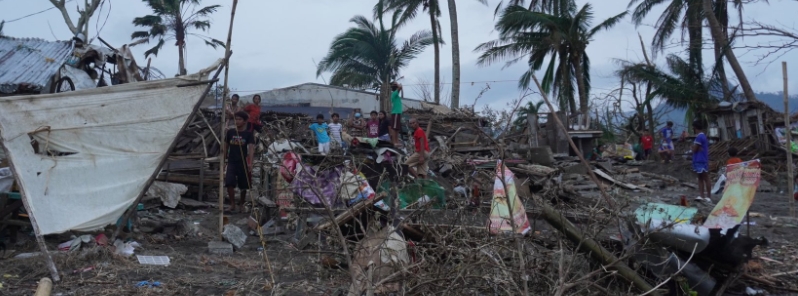Super Typhoon “Goni” leaves 20 dead in Philippines, country’s strongest storm on record

Super Typhoon "Goni" (locally named Rolly) has left at least 20 fatalities and about 230 million dollars (11 billion pesos) worth of damage in the Philippines, the National Disaster Risk Reduction and Management Council (NDRRMC) reported Thursday, November 5, 2020. Up to 1.2 million people or 300 000 families have been affected in Regions II, III, and V; CALABARZON, MIMAROPA, and NCR. It made landfall over Bato, Catanduanes, and Tiwi, Albay, on October 31, with maximum sustained winds of 225 km/h (140 mph) and gusts to 280 km/h (174 mph), making it the world's most powerful storm of the year and the country's strongest landfalling tropical cyclone on record.
Following its first landfall over Catanduanes, Goni brought severe flooding to wide swaths of the Bicol region, as well as lahar flow from the nearby Mayon volcano.
Goni cut a path of destruction as it smashed infrastructure, toppled trees, and caused mudslides.
At least 20 fatalities were reported, mostly from Bicol, while three others remain missing. At least 165 people sustained injuries in the storm's onslaught.
In Camarines Sur, widespread power outages occurred as strong winds lashed the region. Flash floods overwhelmed local villages, while roads were blocked by debris from lahar flow from Mayon volcano.
Hundreds of houses were submerged, with the famous tourist destination Cagsawa Ruins heavily inundated and engulfed with mud. Significant damage was reported to Naga Airport and Legazpi Airport, along with the loss of contact with Virac Airport.
"We have experienced terrible wind speeds, lashing rains, and devastating flooding," said Oxfam Philippines’ Country Director Lot Felizco.
"Goni knocked out mobile phone service, power lines, uprooted trees, and caused damage to critical infrastructure, including hospitals and markets. Homes made of light materials, particularly those near Mayon Volcano, were engulfed in floodwater and volcanic mudflows."
A total of 44 700 ha (110 000 acres) of agricultural land was ravaged by the typhoon. Overall, the NDRRMC reported that the damage to agriculture and infrastructure has climbed to more than 230 million dollars or 11 billion pesos.
44 033 houses were damaged, with 14 064 classified as totally destroyed and 29 969 as partially affected in CAR, MIMAROPA, and Bicol.
Up to 1 197 888 people or 312 583 families were affected, with 171 531 people or 44 524 families being accommodated in evacuation centers.
This included regions II, III, and V, CALABARZON (Cavite, Laguna, Batangas, Rizal, and Quezon), MIMAROPA (Mindoro, Marinduque, Romblon, and Palawan), Bicol, and Eastern Visayas.
The flood has reached the roof in Barangay Busa, Daraga, Albay due to the onslaught of #RollyPH. Residents who live near Cagsawa Ruins also experienced heavy rains and flooding as in photos taken at 9am Sunday. | Photos by AJ Mirasol pic.twitter.com/sWHiiSwcUz
— ABS-CBN News Channel (@ANCALERTS) November 1, 2020
Aerial inspection by Philippine coastguard and OCD of damage caused by typhoon Rolly in Catanduanes (video from PCG) pic.twitter.com/IacxVdGEPS
— Jeannette Andrade (@jiandradeINQ) November 2, 2020
#PRRD conducts aerial inspection of areas hardest hit by Typhoon Rolly
PASAY, Nov. 2- President #Duterte also visited Guinobatan, Albay to meet with residents severely affected by the Typhoon#RollyPHhttps://t.co/gZTUIrQkWM pic.twitter.com/sAwCBSYkNt
— PIA-NCR (@PIA_NCR) November 2, 2020
We arrived late afternoon in Brgy. Sabang, San Jose, one of our Community Learning Hub pilot areas. Another coastal community where many lost their homes to the typhoon.
Our hub had minor damage, but our volunteers kept supplies safe and will resume assisting learners soon. pic.twitter.com/hPibDTk6YX
— Leni Robredo (@lenirobredo) November 4, 2020
The storm made its third landfall near San Narciso, Quezon, and its fourth landfall in the vicinity of Lobo, Batangas, on November 1. In Batangas, hundreds of families were trapped after floodwaters struck, while thousands of families were forced to evacuate after the Laguna de Bay overflowed by 2 m (6 feet).
"Typhoon Goni has caused massive devastation across the island of Luzon in the Philippines," said the European Union's High Representative Josep Borrell and Commissioner Janez Lenarcic in a joint statement.
"We stand by all those affected, and in particular express our sincere condolences to the families and friends of those who have lost their lives. As a demonstration of our solidarity with the Filipino people and the country's authorities, the European Union is mobilizing immediate humanitarian assistance."
"This will enable our humanitarian partners on the ground to provide critical support to the people of the affected regions, helping to meet their immediate needs and to restore their homes and livelihoods."


Goni made landfall with maximum sustained winds of 225 km/h (140 mph) and gusts to 280 km/h (174 mph), equivalent to a strong Category 5 hurricane. It became the Philippines' strongest landfalling tropical cyclone on record, with Super Typhoon "Haiyan" being the second.
Goni is also the fifth strongest tropical cyclone in the world's history.
Featured image credit: Vice President Leni Robredo

Commenting rules and guidelines
We value the thoughts and opinions of our readers and welcome healthy discussions on our website. In order to maintain a respectful and positive community, we ask that all commenters follow these rules:
We reserve the right to remove any comments that violate these rules. By commenting on our website, you agree to abide by these guidelines. Thank you for helping to create a positive and welcoming environment for all.